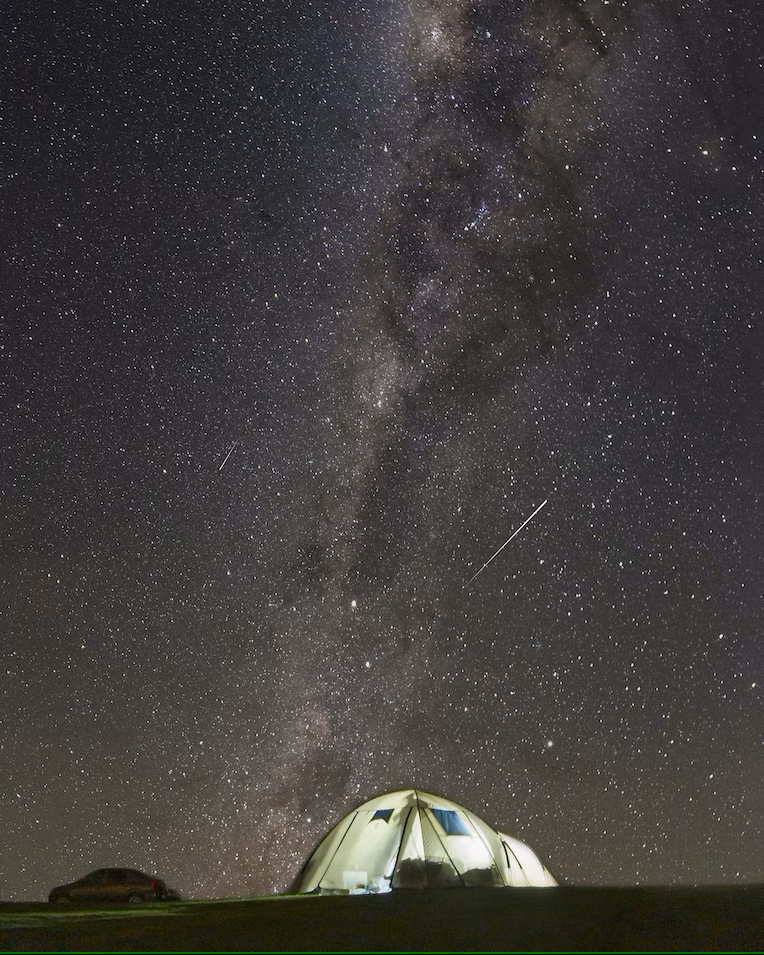Hey there, sky enthusiasts! Get ready to be amazed because the incredible Perseid meteor shower is making its grand appearance this weekend on August 12th and 13th, 2023. Here is your ultimate guide to spotting this breathtaking celestial event that’s lighting up our skies.
The Perfect Time to Catch the Show
Starting from July 17th and going all the way to August 24th, the Perseid meteor shower has been gracing our heavens. But the real magic is about to happen this weekend! Set your alarms for the early hours of the morning on August 12th and 13th, because that’s when the meteor shower will be at its peak. And guess what? This year, the moon will be just around 10% illuminated during the peak mornings, making the meteors shine even brighter. A new moon on August 16th is giving us this incredible lunar advantage.
Get Ready for a Meteor Party
Get ready to be showered with meteors! At the start, you might only spot about one meteor per hour – not too different from a regular stargazing night. But as we hit the peak this weekend, get ready to be dazzled, as the number of meteors could reach an astonishing 50 to 75 per hour. Some lucky viewers might even witness up to 100 meteors in an hour – now that’s a meteor party!
The Secret Behind the Perseid Meteor Shower
Picture this: Earth cruising along its path around the sun, and as it does, it encounters the leftover bits and pieces from comets. These cosmic leftovers create meteor showers like the Perseids. When these tiny dust or rock particles enter our atmosphere at crazy high speeds, they heat up due to friction with the air, creating a magnificent flash of light that zips across the sky.
The Cosmic Superstar: Comet Swift-Tuttle
The Perseid meteor shower is actually brought to us by none other than comet Swift-Tuttle. This comet takes a whopping 133 years to complete its journey around the sun. The last time we could catch a glimpse of it was in 1992, and we won’t see it again until 2125. But don’t worry, it left us with this spectacular show to enjoy in the meantime!
Why “Perseid”? Let’s Unveil the Mystery
Ever wondered why it’s called the Perseid meteor shower? Well, it’s named after the constellation Perseus, where the meteors seem to start their dazzling journey. And here’s a tip: If you’re in the northern hemisphere and you can spot the Cassiopeia constellation, the Pleiades star cluster, or the bright star Canopus, you’re in the perfect spot to witness this cosmic spectacle.
Where to Look? Everywhere!
No need to be an astronomy pro to catch these shooting stars. Just let your eyes adjust to the darkness, and keep an eye out for meteors streaking across the sky in all directions. They’ll appear and disappear in the blink of an eye, adding to the excitement. And keep your hopes high – you might even spot some jaw-dropping fireballs that are as bright as Venus!
Timing is Key
Want to make the most of this meteor extravaganza? A few days before and after mid-August are your best bet for catching some shooting stars. Check the weather forecast for clear skies, and aim to look up on any clear night during that week. Remember, it’s better to catch the show before the peak rather than after. And no matter where you are in the world, just after midnight is the prime time to start looking up.
Boost Your Chances of Seeing the Magic
You don’t need to travel to the ends of the Earth to witness this spectacle – but a dark sky definitely helps. If possible, find a spot away from bright lights like streetlights. Parks are great, and if you’re at home, turn off those lights and find an open view without any obstructions. Get ready to have your breath taken away by the cosmic show of a lifetime!
So, there you have it, folks! The 2023 Perseid meteor shower is gearing up to put on an extraordinary performance, and you’re invited. Grab your snacks, get cozy, and prepare to be wowed by shooting stars, fireballs, and the sheer wonder of our universe. Happy meteor hunting! 🌠

thanks for info